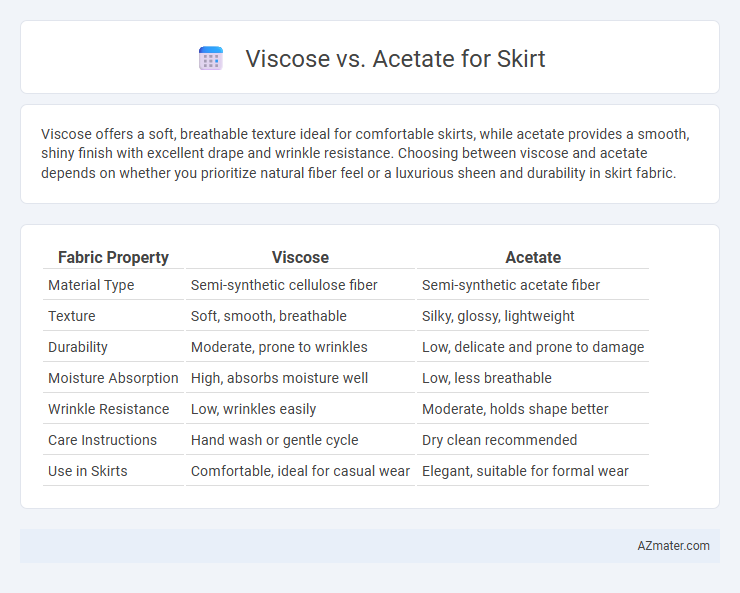Viscose offers a soft, breathable texture ideal for comfortable skirts, while acetate provides a smooth, shiny finish with excellent drape and wrinkle resistance. Choosing between viscose and acetate depends on whether you prioritize natural fiber feel or a luxurious sheen and durability in skirt fabric.
Table of Comparison
| Fabric Property | Viscose | Acetate |
|---|---|---|
| Material Type | Semi-synthetic cellulose fiber | Semi-synthetic acetate fiber |
| Texture | Soft, smooth, breathable | Silky, glossy, lightweight |
| Durability | Moderate, prone to wrinkles | Low, delicate and prone to damage |
| Moisture Absorption | High, absorbs moisture well | Low, less breathable |
| Wrinkle Resistance | Low, wrinkles easily | Moderate, holds shape better |
| Care Instructions | Hand wash or gentle cycle | Dry clean recommended |
| Use in Skirts | Comfortable, ideal for casual wear | Elegant, suitable for formal wear |
Overview: Viscose and Acetate for Skirt Fabrics
Viscose and acetate are both semi-synthetic fibers commonly used in skirt fabrics, offering unique textures and drape qualities. Viscose, derived from cellulose, provides a breathable, soft, and smooth feel with excellent moisture absorption, making skirts comfortable for warm weather. Acetate, made from cellulose acetate, is known for its glossy finish and lightweight nature but tends to be less durable and prone to wrinkling compared to viscose.
Fiber Origins: How Viscose and Acetate Are Made
Viscose is a semi-synthetic fiber derived from regenerated cellulose sourced primarily from wood pulp, often from beech, pine, or eucalyptus trees, processed through chemical treatments to transform natural fibers into a versatile textile. Acetate, on the other hand, is a synthetic fiber produced by chemically acetylating cellulose, typically sourced from cotton linters or wood pulp, resulting in a smooth, lustrous fabric used in lightweight skirts. Both fibers originate from cellulose but differ in their chemical processing methods, impacting their texture, durability, and moisture absorption properties.
Texture and Feel: Comparing Comfort Levels
Viscose fabric offers a smooth, silky texture with excellent breathability, making skirts feel soft and comfortable against the skin. Acetate, known for its lustrous sheen and crisp finish, provides a lightweight but slightly stiffer feel that may be less breathable. Skirts made from viscose generally deliver superior comfort for extended wear, while acetate skirts excel in maintaining shape and a polished appearance.
Breathability and Moisture Management
Viscose offers superior breathability and moisture management compared to acetate, making it more comfortable for skirts in warm climates. Its natural cellulose fibers allow better air circulation and absorb moisture effectively, reducing sweat accumulation. Acetate, being less breathable and slower to wick moisture, tends to retain heat and feel damp, which can lead to discomfort in skirts worn for extended periods.
Durability and Wear Resistance in Skirts
Viscose skirts offer moderate durability with good breathability but tend to weaken and pill over time when exposed to moisture or frequent wear. Acetate skirts exhibit lower wear resistance, often showing early signs of abrasion and color fading due to their delicate fiber structure. For longer-lasting skirts, viscose generally outperforms acetate in maintaining structural integrity under regular use.
Color Retention and Dyeing Capabilities
Viscose offers superior dye absorption due to its cellulose-based fibers, resulting in vibrant and long-lasting colors for skirts. Acetate, derived from cellulose acetate, exhibits moderate color retention but tends to fade faster when exposed to sunlight or frequent washing. The dyeing capabilities of viscose allow for a broader color spectrum and deeper shades, making it a preferred choice for skirts requiring intense and durable hues.
Drapability and Styling Differences
Viscose offers excellent drapability for skirts, creating fluid, soft folds that enhance feminine silhouettes and provide breathable comfort. In contrast, acetate has a glossy finish with moderate drapability, resulting in skirts that hold more structured shapes and exhibit a silky, luxurious appearance. Styling skirts made from viscose suits casual and flowy looks, while acetate skirts align better with formal or evening wear due to their sheen and stiffness.
Care Requirements: Washing and Maintenance
Viscose skirts require gentle hand washing or dry cleaning to maintain fabric integrity, as the material weakens when wet and can shrink or distort. Acetate skirts demand dry cleaning or very careful hand washing in cold water, avoiding heat exposure to prevent fabric damage and color fading. Both fabrics benefit from air drying flat and ironing on low heat with protective cloth to preserve texture and shape.
Price Comparison: Viscose vs Acetate Skirts
Viscose skirts generally offer a more affordable price point compared to acetate skirts due to lower production costs and widespread availability of raw materials. Acetate skirts tend to be priced higher because of their luxurious sheen and more complex manufacturing process, positioning them as a premium choice. Consumers seeking budget-friendly options often prefer viscose for skirts without compromising on appearance or comfort.
Eco-Friendliness and Sustainability Factors
Viscose skirts are made from regenerated cellulose fibers derived from wood pulp, offering a semi-synthetic option that biodegrades more readily than fully synthetic fabrics, but its production often involves chemicals with environmental concerns. Acetate skirts, also produced from cellulose, utilize acetic acid in processing, which is less harmful than some viscose chemicals, yet acetate is less biodegradable and often blended with synthetic fibers reducing its eco-friendliness. Sustainable choices lean towards viscose sourced from responsibly managed forests and produced with eco-certified processes, while acetate, though silky and lustrous, generally ranks lower in biodegradability and sustainability metrics.

Infographic: Viscose vs Acetate for Skirt
 azmater.com
azmater.com